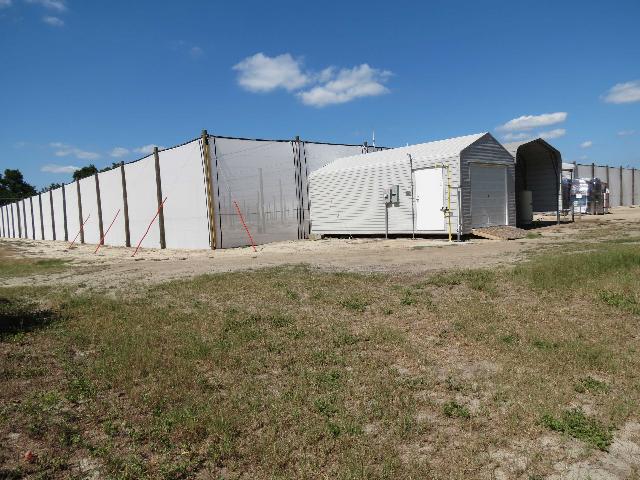How to Implement the CUPS System
CUPS is a new citrus production system for growing HLB-free fresh fruit. It works by total exclusion of the ACP vector.
This solution to HLB may seem simple, but in reality it is more complex, relying on novel integrated approaches for optimizing all management practices, including pest and disease management, planting densities, variety and rootstock selection, irrigation and fertilization, hedging and topping, harvesting, and marketing.
The CUPS significantly increases the cost of citrus grove establishment due to the high cost of screen house construction (up to $1 per square foot). The 40- to 50-mesh high-density polyethylene screen may need replacement every 7 to 10 years (up to $0.5 per square foot). High-quality construction, including setting support poles in concrete, can help to minimize potential wind-related damage in the future. Mites and thrips may selectively enter through the permeable screen, while some of the larger beneficial pest predators are excluded. Greasy spot and other fungal diseases may also thrive in the more humid conditions of the screen house environment. These non-lethal but economically important pests and diseases must be adequately controlled with integrated pest management approaches customized for CUPS in order to avoid loss of fruit quality and yield.
Fortunately, ACP has been successfully excluded long-term by the UF/IFAS screen house structures, which is the main goal of CUPS. Only one adult psyllid was found on a yellow sticky trap in the UF/IFAS CREC CUPS during nearly three years of weekly scouting and monitoring, and no HLB incidence has been confirmed yet on the 1,000 screen-house-protected trees. The most vulnerable ACP entry point of a screen house is through the doors, from movement of personnel and equipment, so standard decontamination procedures should be followed. In particular, citrus leaves and other grove debris that adhere to personnel or equipment should be carefully removed before personnel enter a CUPS facility, since grove debris could carry live ACP eggs, nymphs, or adults that can be dropped in the screen house and cause an infestation. Double-door or foyer entrances are the minimum requirement for preventing ACP entry into CUPS, and the trees should be regularly inspected for ACP and signs of their feeding damage on leaves.

Figure 2. Steel roll-up door with a second plastic strip door, inside the CREC CUPS.
In order for a CUPS production system to be profitable, the higher cost of CUPS must be offset by the highest possible yield of premium-quality fresh fruit with a high market price. High price and market stability are therefore critically important additional criteria for selecting the best fresh fruit variety to grow with CUPS because the economic break-even price per box of fresh fruit is likely to be in the region of >$20. Early-maturing fresh fruit varieties have additional advantages over late-maturing varieties because their fruits have to be protected from pests and diseases for less time. Thus, the risk of freeze damage to fruit is reduced, and routine pruning operations including mechanical hedging and topping can be conveniently conducted in the time between the end of harvest and the following bloom.

Figure 1. The UF/IFAS CREC CUPS facility near Lake Alfred, FL. Credit: Arnold W. Schumann, UF/IFAS
Trees can be grown in-ground and also in pots inside the CUPS. In-ground trees developed a fuller canopy more quickly than potted trees, although fruit yields were similar within the first three years. Juice quality, however, can be better (higher BRIX, acidity) for potted than for in-ground trees.
The fruit yields should also be produced as early as possible in order to achieve the desired early return on investment. Several different cultural methods for accelerating growth and optimizing early yields are being studied at the UF/IFAS CUPS facilities. These include intensive hydroponics with daily or hourly delivery of all essential nutrients by drip fertigation to the trees; higher planting densities (871 and 1,361 trees per acre); selecting heat-tolerant, self-pollinating, seedless, precocious varieties without strong alternate bearing habits; dwarfing rootstocks for limiting tree size when trees are grown in the ground; or even growing trees in containers to limit tree sizes with any rootstock.
Resources
- Citrus Under Protective Screen (CUPS) Production Systems
- Update on Citrus Undercover Production Systems Research
- Planting Citrus Under Protective Screen Goes Commercial
- Scientists on Inside Track to Shut Out Citrus Greening



